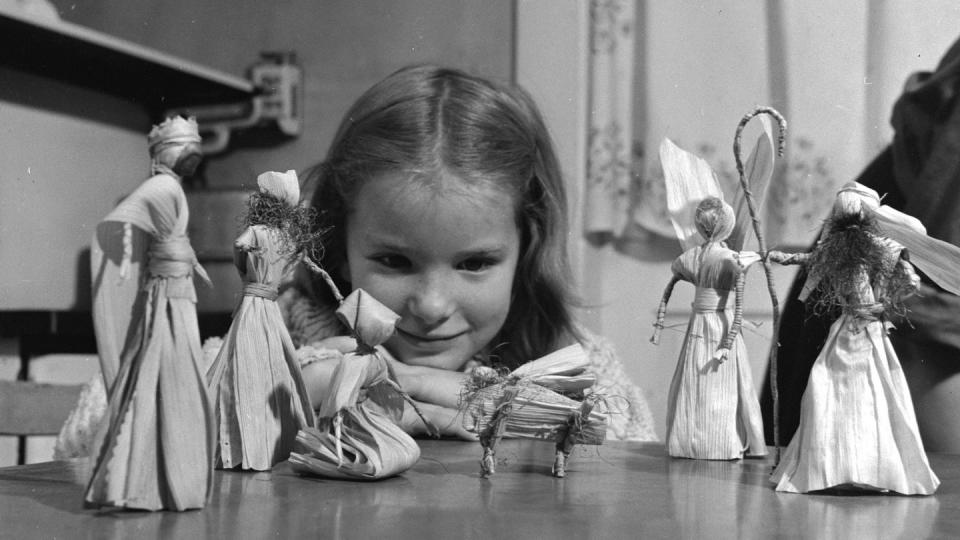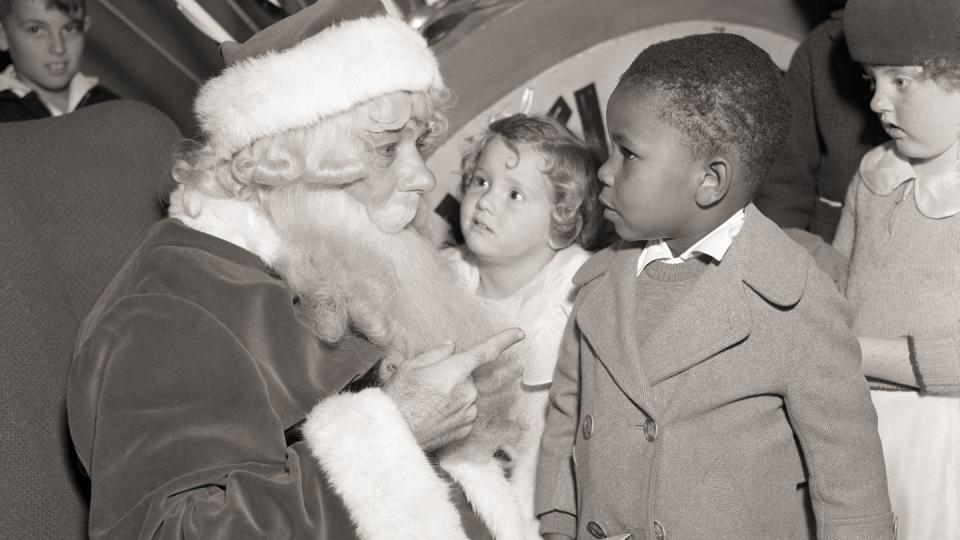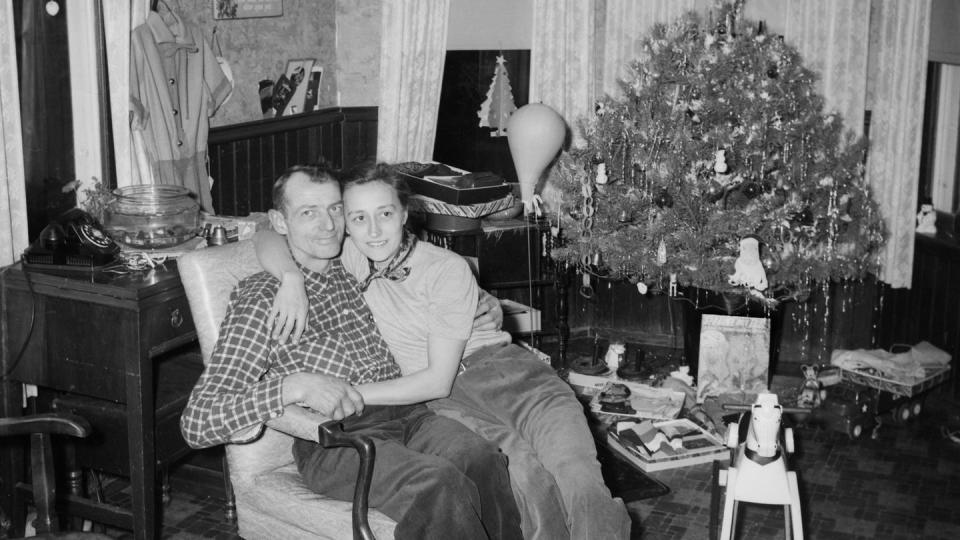Here's the History of Christmas and All of Your Favorite Festive Traditions
- Oops!Something went wrong.Please try again later.
From Dr. Seuss to Charles Dickens, Christmas stories have always captivated people. Many of us can remember sitting at someone's knee to hear a folkloric tale of Kris Kringle and his helper elves. Insert: all of our favorite Christmas books. Heck, the entire holiday has fairytale elements! You have the magical Christmas tree decorations, a special Christmas dinner, and a mysterious gift delivery with all you've wished for. We all accept these as simply Christmas traditions but have you ever stopped to wonder, what's the real history of Christmas?
It's a Christian holiday, so it has religious significance. Artists have been painting the nativity scene for centuries, and innumerable movies have been made to explore the holiday's joyful themes. But what's the deal with the jolly man in the big red suit? Why do we keep decorated trees in our homes? And why are those ornaments traditionally round? If you really think about it, there is a lot to be learned.
As with the real story of Halloween, the history of Christmas is much older than we may think. Our beloved traditions have evolved over the years in ways we could not imagine. So, read on to get to the holly jolly heart of it all!

What is the real story behind Christmas?
We all know that Christmas is celebrated on December 25, but this wasn't always the case! For two millennia, people from around the world have been celebrating Christmas day as the birth of Jesus of Nazareth. But, surprise surprise, the Bible doesn't mention a specific time or date for Jesus' birth at all!
December was already a significant month prior to Christianity, as many people celebrated the winter solstice as a turning point where the worst of winter was behind them. The Norse in Scandinavia celebrated Yule from December 21 through January in recognition of the sun's return. Families would bring home large logs, set them ablaze, and feast until the last sparks went out. In much of Europe, December was the time when most cattle were slaughtered, and wine and beer had finally fermented and were ready for consumption.
Farther south in Rome, winters weren't so harsh, but they still observed a holiday called Saturnalia throughout December and Juvenalia on December 25. Saturnalia honored the god of agriculture, while Juvenalia was a feast to honor the children of Rome and the infant god Mithra. In all of these cultures, evergreens were an important part of decorating during these celebrations.
During early Christianity, Easter was the central holiday. Christians believed that Jesus was born on January 6, but Christmas wasn't even celebrated. That all changed when Pope Julius I chose December 25 as the official date to celebrate the birth of Jesus. Why did Julius make this change? Well, the common belief is he chose the new date to help adopt and absorb the pagan festivals that occurred during the same time. This would then attract the masses to Christmas instead, which it ultimately did.

How did Christmas traditions start and why?
Initially named the Feast of the Nativity, the holiday spread to Egypt by 432 and England and Germany by the sixth century. Believers went to church, then had a raucous celebration with wine and a carnival-like atmosphere. The Christmas traditions were much like the pagan ones from the solstice and Juvenalia, which were now absorbed into the single day.
One fascinating part of the original tradition involves a dynamic between the rich and the poor on Christmas. According to History.com, Beggars and students would go to a lord's house and demand their best food and wine. If the master didn't comply, the visitor would cause mischief. The holiday became a day for the rich to repay their debt to society by giving gifts or entertainment to the less fortunate.
By the 16th century, Germany began the tradition of bringing Christmas trees into the home. Many believe that the reformer Martin Luther was the first to add lighted candles to the tree, a precursor to Christmas lights. The practice of giving homemade gifts is believed to have started in the 1700s but wrapped presents came into the picture in 1800s New York.

How did Christmas become an American holiday?
As we often do, Americans took the holiday and ran with it. Americans did not embrace Christmas until the 1800s, but we basically reinvented it once we did. The 19th century saw a lot of class conflict. So, wealthy New Yorkers responded to the massive discontent by changing the ethos of the holiday, according to The Atlantic.
Best-selling author Washington Irving wrote The Sketchbook of Geoffrey Crayon, gent., in 1819. The popular series of stories set Christmas in an English manor house and transformed the celebration into a peaceful, warm-hearted, family-centered holiday that brought everyone together regardless of wealth or social status.
Simultaneously, Charles Dickens published A Christmas Carol in England, and its message about Christmas charity struck a cultural cord. Children's emotional needs were also reconsidered during this time, and Christmas became a day to "spoil" little ones.
Wait, but who invented Santa Claus?
Okay, Santa was kind of a real person. A real monk named St. Nicholas was born in Turkey around 280 A.D. The legend goes that he traveled the country giving away his wealth, and became known as the protector of children. His feast day is celebrated on the anniversary of his death, December 6. In parts of northern Europe, the day is celebrated with special cookies and gifts. Children will leave letters for St. Nicholas and carrots for his donkey then wake to find presents under their pillows or in their shoes and stockings. Sound familiar?
Good ol' Saint Nick entered American culture thanks to Dutch immigrants who celebrated Sinterklaas (a shortened form of Sint Nikolaas or Dutch for Saint Nicholas), but he wasn't popularized until the 1822 poem "Twas The Night Before Christmas." Then, in 1881, political cartoonist Thomas Nast drew on the poem to create the jolly red image of Old Saint Nick we know today. This image of Santa that we know and love was only further defined by the beloved Coca-Cola Company Christmas advertisements first created in 1931 by illustrator Haddon Sundblum, featuring a bright red suit, matching cap, and boots.
You Might Also Like

